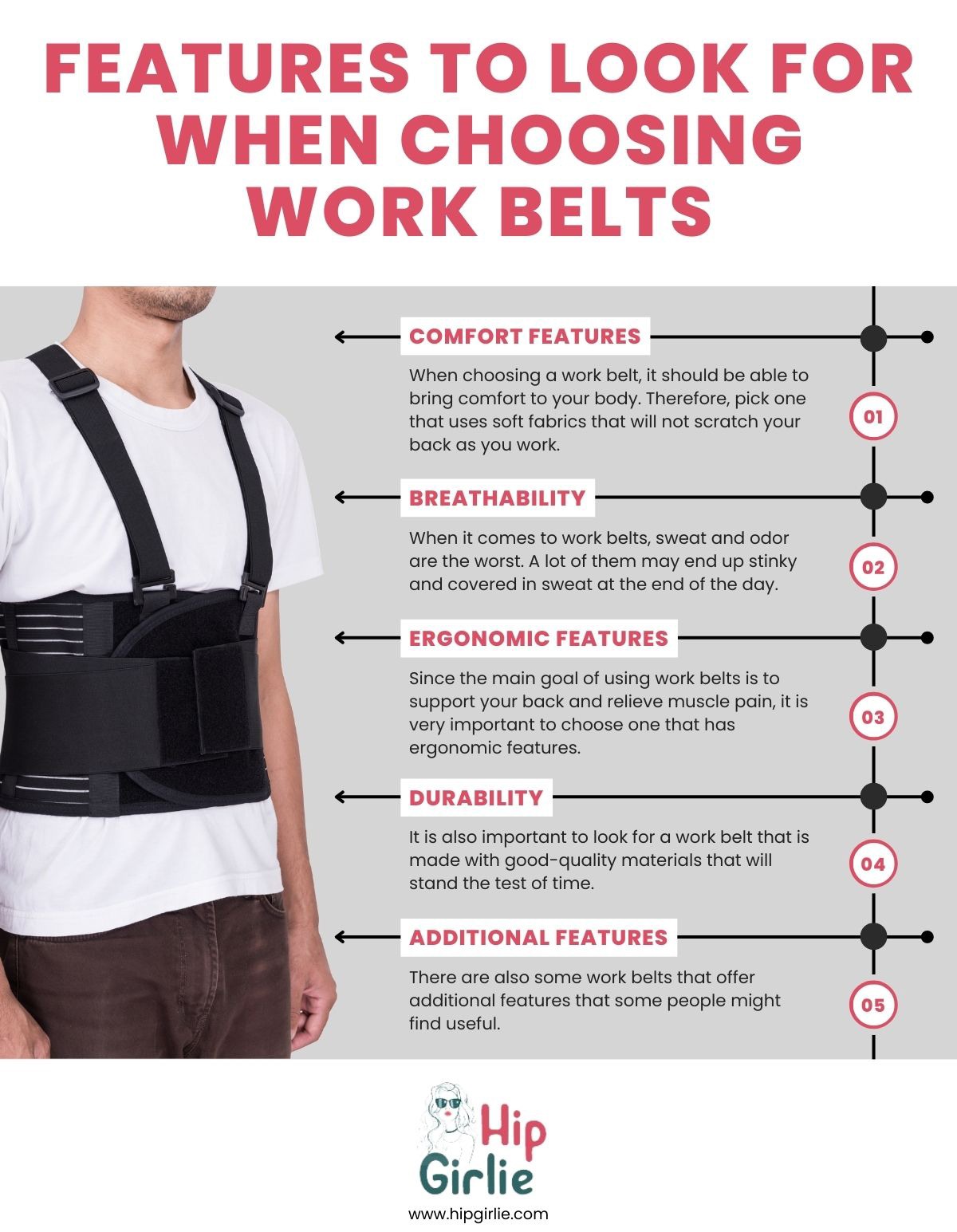If you work long hours on the job in physically demanding tasks that need heavy lifting or repeated motions, you may have wondered if wearing a work belt could make your job easier and safer. Work belts, particularly back support belts, are intended to provide extra support and lower the chance of injury while on the work. But are they appropriate for you? In this post, we’ll look at the advantages and disadvantages of wearing a work belt, specifically a back support belt, so you can decide whether it’s worth considering. Whether you’re an experienced worker or just starting out, read on to learn if a work belt is the solution you’ve been waiting for.
How Did Work Belts Become Prevalent Among Works?
Back injuries at work are a severe problem that costs the United States billions of dollars annually. As a result, work belts and back braces have grown in popularity, especially in vocations that require heavy lifting or repetitive actions. According to the Centers for Disease Control and Prevention, back injuries account for around 20% of all workplace injuries, making work belts one of the most popular things for employees looking to protect their backs and avoid damage.
Lower back discomfort is a frequent problem that affects a wide range of people, regardless of career. On the other hand, heavy lifting professions can put additional pressure and injury on the spine, making people more prone to problems including herniated discs, degenerative disc disease, spondylolisthesis, and sciatica. If you work in a job that needs you to lift large objects, such as construction, warehouse labor, or moving, wearing a work belt may help you lessen the pain and discomfort you feel afterward.
Repetitive lifting and motions can cause wear and tear on the spine, particularly in the lower back. This can make people more vulnerable to diseases and injuries that may necessitate surgery. Maintaining appropriate form at work is, therefore, critical for general health, and utilizing a work belt can assist workers in achieving proper form, minimizing the chance of injury and preserving their backs from additional harm.
View this post on Instagram
Should You Use Them: The Benefits of Work Belts
The usage of lower back belts to alleviate lumbar discomfort is not a novel concept. In reality, they have long been employed in medical rehabilitation settings. However, due to their potential to alleviate back pain and provide additional support when lifting large things, back belts have gained appeal as workplace and weightlifting aids in recent years.
Wearing a work belt while working can alleviate stress on the spine, especially in the lower back. This is performed by increasing intra-abdominal pressure, which counteracts the pressures acting on the spine. The increased support given by the work belt helps to lessen the load on the spine by hardening it, allowing the muscles to perform more efficiently and lowering the risk of injury when lifting.
Work Belts Help Prevent Back Injuries
Back injuries can be severe and debilitating if you have ever encountered sudden, paralyzing pain in your back while working. Chronic discomfort, limited mobility, and even disability can result from back injuries.
One of the advantages of wearing a work belt is that it can stabilize your back and avoid injury. Work belts are intended to support the lower back by squeezing the muscles in the back and abdomen. This compression reduces the load on the spine and reduces the chance of damage.
View this post on Instagram
Work Belts Also Help Maintain Proper Posture
One advantage of wearing a work belt is that it can help you maintain proper posture, which can help you avoid back pain and damage. Work belts are meant to support the lower back, which can help to improve posture and prevent spinal strain.
Wearing a work belt will assist in correcting any improper posture patterns you may have formed. Even when performing physically demanding duties such as heavy lifting, work belts can help to straighten the spine and preserve appropriate posture. Over time, this can assist in lowering the risk of back pain and damage.
Work belts can also help develop excellent posture by pushing you to utilize your core muscles. Wearing a work belt may cause you to automatically engage your abdominal muscles, which can support your lower back and improve your overall posture.
Work Belts Provide a Good Support for the Back
Back pain can be a serious medical condition that makes it difficult to work or conduct daily activities. A work belt or back belt is one possible remedy for those who suffer from back pain. These belts are intended to support the lower back, which can reduce muscle strain and relieve pain.
When you wear a work belt or back belt, the pressure from the belt can help to compress the muscles in your lower back, providing pain relief. This compression can lessen muscle strain and relieve any tension that may be contributing to the pain.
Work belts, in addition to offering pain relief, can assist you in continuing to work despite back problems. Work belts can help prevent the risk of further injury or exacerbation of existing discomfort by supporting the lower back. This allows you to accomplish your job obligations more easily and without the risk of worsening your condition.
View this post on Instagram
Work Belts Have Drawbacks Too
Like other items, work belts or back support belts have a few drawbacks. Having weak muscles is one of them. Because when a person gets overly reliant on his belt, his core and abdominal muscles may atrophy. As a result, remember that these belts are only intended to provide back support and not complete protection. When lifting, it should not boost your self-confidence or sense of security.
Work Belts Can Develop Dependency
While utilizing a back support belt can be advantageous in reducing back muscle strain and providing support, there is a possible disadvantage to relying on it too extensively. If you use the belt too frequently, your back muscles may weaken and become less capable of supporting your spine without the belt.
This can lead to a dependency on the belt, making your back muscles weaker and less resilient. If you rely too heavily on the belt, your back muscles may become fatigued, resulting in more tremendous pain and discomfort.
To avoid this potential disadvantage, use a back support belt properly. This means using it only when necessary and gradually lessening your reliance on it as your back muscles strengthen and adapt. Exercises and activities that can develop your back muscles, such as stretching, resistance training, and core strengthening exercises, are also important.
Work Belts Can Provide a False Sense of Security
While a back support belt can provide valuable support and aid to lessen tension on the back muscles, it’s vital to remember that it won’t prevent you from all sorts of back ailments. This can give some employees who wear the belt a false sense of security, as they may believe they can move heavy objects or work in odd positions without risking damage.
In truth, a back support belt is not a guarantee against harm, and other factors might contribute to back pain and damage at work. For example, lifting large objects with bad posture or in odd positions can still significantly strain the back muscles, even if you use a back support belt.
Furthermore, a back support belt may not benefit all types of back ailments, such as those caused by overuse or repetitive strain. In these circumstances, taking extra precautions to avoid injury, such as altering your work posture, taking regular breaks, and engaging in stretching and strengthening exercises, may be necessary.
View this post on Instagram
Work Belts Are Not for Everyone
While back support belts can help reduce the risk of back pain and injury, they can be difficult to wear for long periods of time for some people. This could be caused to a number of things, including the belt’s bulkiness or the pressure it exerts on the abdomen.
People who wear back support belts frequently say that they are bulky and tight, making it difficult to move and work comfortably. This can be especially troublesome for individuals who must move swiftly and effortlessly on the job, such as those in construction or warehousing environments.
Back support belts can also put pressure on the abdomen, which can be uncomfortable or even painful for certain people. This is especially true for pregnant women and people who have pre-existing abdominal disorders like hernias or digestive issues.
To address these concerns, it is critical to select a back support belt that fits properly and provides adequate support without being overly bulky or restricting. Consider belts made of lightweight, breathable materials that allow for a lot of mobility and flexibility, as well as adjustable belts that may be tailored to your body form and size. Check this infographic below to learn about the different factors to consider when buying a work belt.
In conclusion, work belts or back braces can provide much-needed support for those who routinely move heavy objects or work in jobs that place pressure on their lower back. However, as with any tool, they have downsides and should be used with caution. To limit the risk of injury, maintain good lifting technique and improve strength in the back muscles. As John Wooden said, “Nothing will work unless you do.” In the end, wearing a work belt is only one component of a bigger effort to protect your back and maintain good overall health.


